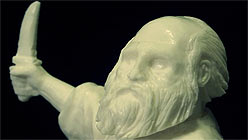You can use the soap but you’d only be getting blood on your hands, literally. Artist Casey Logan alludes to Christ’s blood as a mechanism of salvation when incorporating his own blood into a bar of soap. His piece, This Soap Won’t Get You To Heaven, is part of Objects of Human Making, this month’s exhibition at SOAP Gallery. The show is an exploration of how something so mundane as lye and animal fat can connote hygiene, cleanliness and even reach into the more metaphysical ideas of purity and order.
The exhibition’s title was taken from Francis Ponge’s 97-page ode to soap, a project begun in France during WWII when the commodity was dearly missed. Guest Curator Carrie Hott asked 6 artists to create work based on a deep consideration of this basic element of human culture, the namesake of SOAP Gallery. The show consists of 9 greatly contrasting and well-thought-out pieces, befitting the gallery’s intimate space.
Leading into the gallery is Erica Gangsei’s trio of hand-made objects — a toothbrush, toothpaste, and blob of soap — mimicking mass-produced items. Gangsei’s true-to-scale toiletries sit in front of information forms, which include ingredients used in the production of each object and outline how each should be used. Gangsei’s Request For Object Etymology Tax Exemption plays with methods for building an informed consumer. The piece includes a detailed proposal for creating more inclusive consumer information labels, which would detail the historical backgrounds on products, producers and each product’s constituent materials.
Sunaura Taylor’s work, Animal, reflects on soap as a form of order and structure. She has arranged a powerful collection of black-and-white, photocopied images into a large, neatly tiled square, covering the gallery’s back wall. Within this framework, Taylor explores how marginalized groups of people and animals have been historically marketed as commodities. Many images document how people with birth defects and missing limbs were exploited as side-show circus attractions during the 1920s and ’30s. Taylor supplements a brief written narrative by doctoring these images with oil paint. She directs the eye with yellow arrows; gives a little girl red lobster claws; and paints out certain body parts in white, while painting in other body parts with flesh tones. Taylor also incorporates charts of quartered animal parts, labeled for different classes of consumption. The mosaic creates a gruesome connection in the marketing of flesh, resonating quietly but powerfully inside the gallery space.
Objects of Human Making explores soap’s many facets, some to the point of Ponge’s fetish-like capacity, and successfully takes soap away from a dull utilitarian perspective. The show reminds us to delve more deeply into the historical context of the commonplace items we use every day.


